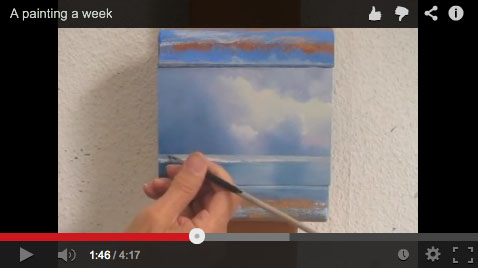Still I managed to finish the painting I've been working on for a while. It's quite big: 80 x 150 cm. I love the large formats. They give a sense of space you don't get on the small ones.
 |
| Tracks, oil on panel, 80 x150 cm |
 I'm writing about this particular painting because I used a different method to paint the clouds. In the first stage I did the blue of the sky, with it's transition from a greenish- to a darker blue. It took me two days and a number of layers to get it right, but that was worth the trouble. The transition gets much smoother and the colors more intense. The next day I did the first layer of the clouds in a mid tone, much like the cloud on the right side of the painting. Used my thumb to give the edges a fluffy look. In the next few days I slowly built up the white of the clouds (Titanium White with a little Vermillion Red to be preciese), using the initial mid tone for the shadow parts.
I'm writing about this particular painting because I used a different method to paint the clouds. In the first stage I did the blue of the sky, with it's transition from a greenish- to a darker blue. It took me two days and a number of layers to get it right, but that was worth the trouble. The transition gets much smoother and the colors more intense. The next day I did the first layer of the clouds in a mid tone, much like the cloud on the right side of the painting. Used my thumb to give the edges a fluffy look. In the next few days I slowly built up the white of the clouds (Titanium White with a little Vermillion Red to be preciese), using the initial mid tone for the shadow parts.I use this method mainly for free floating clouds against a blue background, but I think I'm going to try it for more overcast skies as well.
Well, that's it for now. Hope you're enjoying the Holiday Season. All the best for you and your loved ones for 2015!

















































